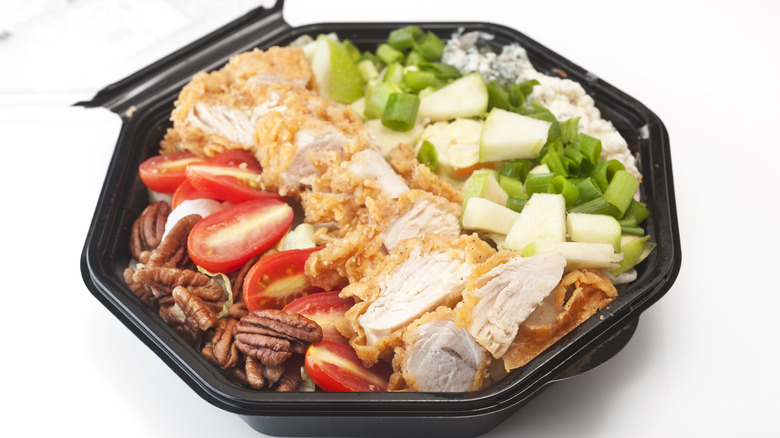Why Salads And Health-Forward Sides Tend To Flop At Fast Food Chains
Ever gone to a drive-thru swearing you'll just get a salad, only to find yourself leaving with a standard combo meal? Then you know just how tempting a classic burger or nugget meal can be. Beyond people craving their usual fast food offerings, there are a few reasons that these healthy offerings don't do well at the drive-thru. In the early 2000s, there was a call for more healthy options on fast food menus, and the big chains listened. So with the availability of more nutritious menu items from fast food restaurants abound, it may be shocking that people continued to enjoy their usual orders at a level that even impulse eating can't fully account for.
After all the clamoring for healthier options, salads only made up a dismal portion of sales at restaurants like McDonald's. But why didn't people go for these offerings in the end? For one, these offerings just weren't ever that good. They usually consisted of little more than romaine lettuce, sliced chicken tenders, and pre-packaged dressing, and some even had more calories than the average burger.
Additionally, one of the key benefits of fast food is that you can eat it in your car, while salads require adding dressing and eating with a fork. Finally, the accessibility of chains like Sweetgreen and Chopt made these items obsolete because when folks really wanted salad they could get it elsewhere on the go.
Anything fast food does, others do better
After the documentary "Super Size Me," there was an influx of criticism against fast food giants but especially McDonald's. The documentary premiered in 2004, targetting McDonald's for causing allegedly causing America's supposed "obesity epidemic" (many of the documentary's claims have now been shown to be dubious at best). Just a year later in 2005, McDonald's started offering salads, as well as wraps in 2011, which were seen as a trend-friendly healthy alternative to regular sandwiches. Other fast-food chains followed.
Wendy's, which previously offered in-store salad bars, increased their drive-thru salad offerings in 2002. Burger King followed a similar model, but it should be noted that even the salad bars of yore had slim profit margins, and their health food descendants didn't do much better. By 2022, McDonald's would nix many of its healthy eating options such as yogurt parfaits, wraps, and yes, salads.
What this tells us is that when people are seeking out more nutritious food options, they'll get it somewhere other than the drive-thru. They'll make a meal at home, or stop off at a Sweetgreen or other fast-casual restaurant like Chipotle, Roti, or Zao. These chains still have decent prices, but far superior ingredients which lead to both more flavorful and nutrient-dense offerings. When customers find themselves pulling into the drive-thru, most are looking for comfort, convenience, and the wonderful offerings of the deep fryer. After all, all things in moderation, right?

